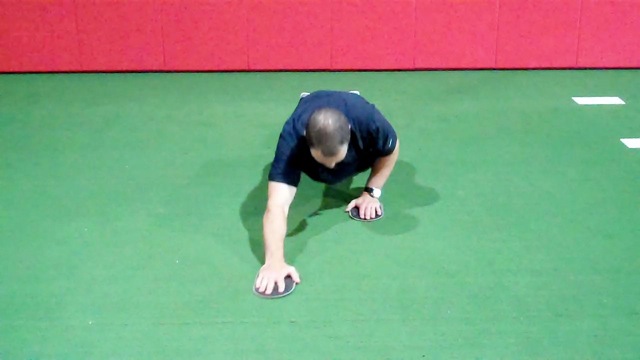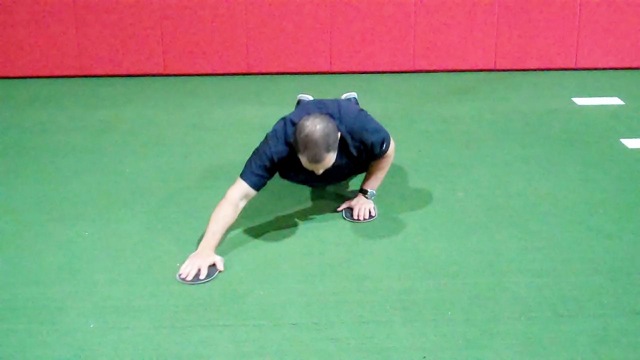
Execution:
|
|
As the client begins to lose form instruct he or she to return to the start position. Then repeat the same motion on the other side. Observe any asymmetry in movement that may be present. Repeat this alternating sequence for 5-10 repetitions on each side. Perform 1-2 sets using a cadence of 2/0/2 or 2/1/2. The latter cadence requires prerequisite strength and control to avoid collapsing or sacrificing form.
|
|
Finally, for the advanced client who masters the quadruped version, consider progressing to the toes in the start position to lengthen the lever arm. However, note that poor hip mobility (namely lack of extension) may quickly compromise spinal alignment in this position. Addressing this deficit if present should happen before taking on this progression. More upper body strength/endurance will be required to perform the exercise in this fashion.
Application:
This exercise can be used to promote shoulder mobility/stability and upper body strength/endurance. It can be effective for those with anterior shoulder laxity. Additionally, it is an excellent way to strengthen the core with respect to deceleration and anti-extension/anti-rotation. I like to use it with my overhead athletes, golfers, and clients with instability issues trying to return to high demand activity.
Precautions/Modifications:
I suggest starting with a small or limited range of motion initially until the client adequately demonstrates control and good motor patterns. Do not push through pain at any time. This exercise may not be suitable for clients with a history of recurrent anterior/inferior shoulder dislocations, gross instability, labral tears or rotator cuff impingement and/or tears.
Possessing sufficient scapular control is integral for this exercise.Using appropriate movement screening or consulting a medical professional is recommended prior to using this exercise in clients with the aforementioned conditions. Additionally, be cognizant of potential anterior shear forces on the lumbar spine in those with tight iliopsoas muscles as the hips extend, since the lumbar spine will compensate for poor hip mobility.
Brian Schiff, PT, OCS, CSCS, is a licensed physical therapist, respected author and fitness professional. Currently, he serves as the supervisor at the Athletic Performance Center in Raleigh, NC. Brian presents nationally at several professional conferences and seminars on injury prevention, rehab and sport-specific training. For more cutting edge training information, subscribe to his monthly Training & Sports Medicine Update at www.BrianSchiff.com.
 Place two sliders beneath the hands while beginning in a quadruped position. Next, slowly slide one hand forward allowing the shoulder to flex, while the other hand remains stationary and the elbow slowly moves into flexion. Throughout the entire descent, the lumbar spine angle should remain neutral. This is best observed from the side.
Place two sliders beneath the hands while beginning in a quadruped position. Next, slowly slide one hand forward allowing the shoulder to flex, while the other hand remains stationary and the elbow slowly moves into flexion. Throughout the entire descent, the lumbar spine angle should remain neutral. This is best observed from the side. Provided the client maintains good alignment in flexion, consider moving to a more diagonal or "Y" position with the sliding arm. This positions the shoulder in a more functional overhead pattern as well as allowing the client to control and introducing spinal rotation toward the stationary arm side. I focus on avoiding pelvic/lumbar rotation during this Y exercise. This is much more difficult in terms of maintaining consistent alignment.
Provided the client maintains good alignment in flexion, consider moving to a more diagonal or "Y" position with the sliding arm. This positions the shoulder in a more functional overhead pattern as well as allowing the client to control and introducing spinal rotation toward the stationary arm side. I focus on avoiding pelvic/lumbar rotation during this Y exercise. This is much more difficult in terms of maintaining consistent alignment.















